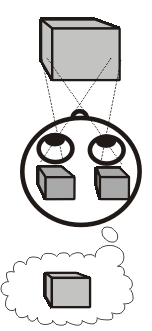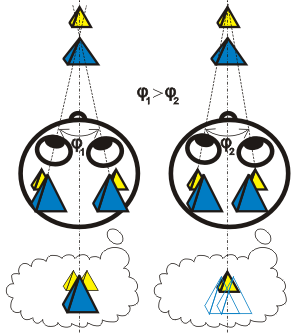2 Physical base of stereoscopic sight
The human eye is able to perceive the light ― one of the electromagnetic energy forms,characterized by the wavelength. The waves with 300-800 nm range are perceived by human as color and brightness sensations. The outward objects can reflect the light(sometimes they radiate the light). That is why these objects are visible for human.
A number of phenomena allows people to get the idea of three-dimensional outworld: geometric and atmospheric perspectives, shadows and catch lights on objects and objects relative sizes. For a long time, artists have been using techniques simulating these phenomena to show the volume of three-dimensional objects on plane.
One more factor allowing us to estimate location of objects in space is the way they move relative to each other when we change our viewing point (closer objects move against those that are behind them). It helps us to evaluate the remoteness of objects from us while we are watching a movie or looking at the scenery out of train window. Relying on the accumulated experience, one can interpret the above phenomena as the evidence of three-dimensional space while looking at real objects, pictures and photos or watching movies. The effect is independent from whether we are looking with both eyes or only with one eye.
When observing the real life objects, one more mechanism of the human sight, called accommodation is playing a role. The human brain evaluates the effort needed to focus the eye on objects and it allows us to get additional information about the location of them in space.
The nature has endued people with a more precise instrument - binocular vision - a pair of eyes parallel located at the distance of 60-70 mm. Due to this, a person sees the world from two points at the same time. As a result, images perceived by the left and right eyes slightly differ. These two images are called stereo pair. Analyzing differences between the images of this stereo pair, the human brain receives information about the volume of objects being watched and the distance to them.

Fig. 1. Parallax: each eye sees any object from its own point; the brain evaluates the difference and produces a three-dimensional image
Perspective (seeming) shift of the object being viewed caused by the changed viewing point is called parallax and it's the general reason we perceive three-dimensional world (Fig. 1).
The mechanism of stereoscopic sight called convergence or divergence (depending on the directionality of action) plays an important role in evaluating distances.
Convergence is converging of the sight lines while looking at objects located at a short distance. Divergence (moving sight lines apart) occurs while looking into the distance. This makes objects located at the intersection of the sight lines look clear and objects located farther or nearer look doubled. You can easily see this doubling if you attentively look at an object located at arm's length from your eyes (for example, your finger) and pay attention to that how remote objects are look like. Usually, we do not even noticing this doubling, but the brain processes it and it helps us to evaluate the remoteness of objects. Besides, the brain takes into account the angle of sight line convergence (Fig. 2).
It is the mechanism of human sight that is used in most methods of viewing stereoscopic(three-dimensional) images.

a) b)
a) when your attention is focused on closer objects (blue pyramid), more distant objects look doubled;
b) when you attention is focused on more distant objects (yellow pyramid), closer objects look doubled.